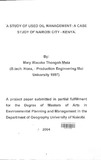| dc.description.abstract | For years, motor oil commonly has been used and reused or discarded in ways that neither protected the environment nor conserved its resource value. In Kenya alone, an estimated 200 million gallons of used motor oil are improperly disposed off by being dumped on the ground, tossed in the trash (ending up in landfills), and poured down storm sewers and drains. Just one gallon of used oil has the potential to contaminate up to one million gallons of drinking water.
Additionally, used oil that ends up in the country's rivers, lakes, and streams can threaten aquatic life. If all of the used oil that is improperly disposed off were properly managed, Kenya could save thousands of barrels of oil each day. Used oil that is properly handled can be re-refined into lubricants, processed into fuel oils, and used as raw materials for the refining and petrochemical industries.
The study aimed at identifying all uses and current disposal methods of used oils, and proposing environmentally friendly disposal methods.
The study chose Nairobi due to its high concentration of motor activity, garages and petrol stations and hence more used oil outlets. Nairobi alone has 452 petrol stations, comprising about 32% of all stations in the country. "Jua Kali" garages are also many and highly concentrated in Nairobi than in any other part of the country. Most of theses garages are makeshift structures erected on road reserves, river banks and in back streets. The highest concentration of the garages is along Nairobi River. Oil is directly disposed into the river, and hence accounts for-the highest water pollution in the region.
The study found out that used oil has more than one uses ranging from dust suppression, lubrication of invalid carriages like wheelbarrows, used for marking fields in schools, mosquito control, termite control, wood preservative, to mention but a few.
Large proportions of used oil are taken away by motorists for undisclosed uses. Flower farms use it as dust suppressant and it is also claimed that it increases green house effect and thus leading to faster growth of the flowers. The largest proportion, over 55 percent, of used oil is given away to third parties freely, some is sold and the rest is poured away. In some few cases, it was reported that used oil is poured into the city council sewer system.
Though the greatest challenge faced by all oil marketers is that of disposal of used oil, a solution to the same must be put in place as a matter of urgency. All possible and current modes of disposal are known to contaminate the environment, very little if not nothing is being done to address the problem. The country lacks a legal framework that encompasses handling of harmful waste with the exception of toxic and radio active waste. It is commendable the efforts petroleum marketers are putting to collect used oil, but it will be seen that proper disposal is not yet in place. Disposal will include burning it in kilns, proper packaging and burying into the soil and treatment to remove toxins and resell for use in timber treatment. | en |

